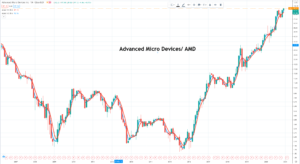
New ‘new high’ for Advanced Micro Devices as Dr Lisu Su aims to make AMD the king of high performance computing

Advanced Micro Devices AMD Buy @ $96 MV: $116bn Next figures: 2 February 2021 Times recommended: 8 First recommended: $36.50 Last recommended: $94
Xilinx/ XLNX Buy @ $150.50 MV: $37.3bn Next figures due: 27 January 2021 Times recommended: 2 First recommended: $126 Last and lowest recommended: $120
Before writing about these stocks, especially AMD, subscribers should note that the latter has agreed to acquire Xilinx in an all-share deal. The deal is expected to close by the end of calendar 2021. Terms are 1.7234 AMD shares for every Xilinx share to leave the latter with 26pc of the enlarged business. At $97 for each AMD share the bid values each Xilinx share at $167.2 making the latter’s shares a cheap way into the enlarged business. The risk is that for some reason the deal does not go ahead. Put another way buying shares in Xilinx at $150.5 is like buying AMD shares for $87.3 (in a year’s time).
People who know about the semiconductor business say there are two eras at AMD, before Lisa Su and after Lisa Su. Su is a 51 year old Taiwanese America, who studied electrical engineering at MIT (Massachussetts Institute of Technology), before having a glittering career at companies like IBM, where she played a leading role in semiconductor research. In 2021 she joined AMD as chief operating officer, becoming CEO in 2014. The key thing about the semiconductor industry is that it has long lead times. It takes several years to go from setting a new direction to having anything to show for it. Su is all about product development. She talks about AMD, which next year should include Xilinx (see below) as being a business with 13,000 engineers. She also describes herself as a geek. After 2012 she increasingly set the direction for AMD, crucially on a new generation of semiconductors, and the effects started to come through from 2016 onwards.
Her impact has been incredible. In 2014 AMD lost $1bn and was deep in debt. The shares were plumbing the depths. Since 2016 they have climbed from $1.52 to fast approaching $100. The company is expected to report 2020 profits over $1.2bn, debt has been completely eliminated and net cash is forecast to top $6bn by year end 2022. The clear implication is that not only is Dr Lisu Su a great engineer but she is also a very talented manager. The company is even coming under pressure to use its strong balance sheet to buy back shares but I suspect Su’s plans for the money will be even more ambitious.
Back in the day, before Su, AMD was a poor man’s, even a very poor man’s Intel. If you wanted great technology you went to Intel, if you wanted cheap and cheerful, virtually commoditised so non-existent pricing power, you went to AMD. As power and efficiency became ever more critical in an increasingly on line, digitally transformed, performance driven world, AMD’s products just didn’t cut it. Not any more; that, to put it mildly, has changed completely. I am not an electrical engineer so I have to be cautious in what I say but my studies of AMD suggest that Su has done a number of things to turn the ship around and build what is becoming one of the world’s great semiconductor businesses. AMD’s chips are still great value but now they deliver performance as well. They have names like Ryzen (notebooks and desktops), Radeon (gaming), EPYC (CPUs – central processing units -for the data centre) and Instinct (GPUs – graphic processing units) for the data centre to build brand awareness.
Pricing power has gone from non-existent to very impressive indeed with operating profit margins , which were negative when Su took charge, forecast to rise from 5.65pc for 2017 to 23.4pc for 2022. This is important not just as a good thing in itself but also because I have noticed a classic pattern at many companies in the past by which great managers improve profitability and then use the higher profits to drive strong sales growth at the new higher margins.
AMD is already flexing its new found muscles with the agreed deal to buy Xilinx. This deal will give the company even more engineering muscle in a world, where top class engineering talent is becoming a scarce resource but will also make the company even stronger in one of its key target areas, the data centre. It will also give the group exposure to new areas like the Internet of Things and autonomous vehicles. Su says there are some 50bn connected devices in the world providing a giant ecosystem powered by the thousands of data centres, which make up the cloud. Her ambition is for AMD to provide the brains (chips and SoCs – systems on chips) to power the data centre and as many of those connected devices as possible. No wonder she talks about a TAM (total addressable market) for AMD and Xilinx’s products of $110bn.
Pre-=Xilinx AMD targeted three core markets, desktop and notebook computers, data centres and gaming. One way it did this was by recruiting marquee customers who want the ideal combination of high performance and value for money that makes their devices and data centres really efficient. It has been highly successful with customers like Sony and Microsoft for gaming, Dell and Apple for computers and Google for data centres. This success did create one vulnerability because around 20pc of sales came from Sony and Microsoft and they have just launched new consoles. This is good for business but in the run up as customers waited for the new consoles to arrive the gaming market was a little soft, which explains why the shares marked time in the summer of 2020. They took off when the group reported Q3 results way ahead of expectations. The shares would have gone even higher but for the simultaneous announcement of the agreed deal to buy Xilinx in an all-share transaction. After the deal Xilinx shares holders will own 26pc of the enlarged business so investors can see a lot of AMD shares hitting the market some time late next year.
Another measure of Su’s ambitions is her plan to make AMD the king of high performance computing. In pursuit of this deal AMD semiconductors are increasingly found in super computers. Su also talks about the shift from a desktop-centric world to a data centric world. She argues that in a world where data is king processing power becomes increasingly important and that more and more applications will be about high performance computing. The secret sauce at AMD, I suspect, is their ability to deliver this high performance capability at an attractive price.
Another exciting thing to remember about AMD is that it doesn’t actually make anything. Other people like Taiwan Semiconductor Manufacturing actually make the chips. AMD is a centre of design excellence and state of the art intellectual property. This is why Su talks about AMD plus Xilinx as a talent pool with 13,000 engineers whose job is to keep improving the technology, which requires new technqiues now that Moore’s Law has slowed down. When any device you use is faster, clever and more capable than its predecessor it is thanks to companies like AMD. They really are the beating heart of the technology revolution. On top of that AMD has Dr Lisa Su, the queen of the semiconductor business. It is an exciting combination that I believe will make AMD plus Xilinx one of the key players in technology and a much bigger business than it is presently.

Xilinx is a cheap way to buy AMD shares but comes with the risk that the deal may not go ahead although it seems much more likely that it will. One strategy could be to invest in both shares.



